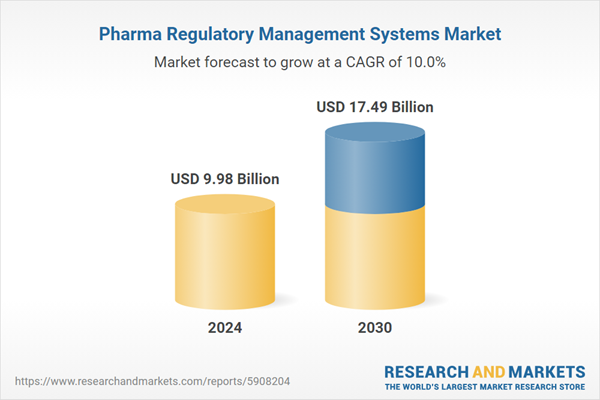Speak directly to the analyst to clarify any post sales queries you may have.
10% Free customizationThis report comes with 10% free customization, enabling you to add data that meets your specific business needs.
For instance, according to GLOBOCAN 2022 data, global cancer incidence surpassed 19.9 million cases. The highest number of cases was reported in Asia, with over 9.8 million, followed by Europe with 4.4 million and North America with 2.6 million. This data highlights regional disparities in cancer prevalence, emphasizing the growing healthcare burden worldwide. Therefore, in order to manage these issues, the regulatory committee of pharmaceutical is growing rapidly.
Key Market Drivers
Rising Regulatory Complexity
The pharmaceutical industry operates in a highly regulated environment, where adherence to stringent regulatory standards is paramount to ensure the safety, efficacy, and quality of pharmaceutical products. Over the years, the regulatory landscape governing this industry has become increasingly complex, with a growing number of guidelines, requirements, and compliance standards imposed by regulatory authorities worldwide. This rising regulatory complexity has emerged as a significant driving force behind the rapid growth of the Global Pharma Regulatory Management Systems (PRMS) Market.For instance, Japan’s Central Social Insurance Medical Council approved a drug repricing system expected to lead to an average price reduction of approximately 4.38%. This system covers nearly 17 top-selling drugs, including Vyndaqel, Samsca, Revlimid, Lynparza, Stelara, and Dupixent. In April 2023, the prices of over 2,000 drugs in Japan saw an average reduction of 9.4%. These developments are likely to impact pharmaceutical regulatory managemnet systems market in the near future.
Key Market Challenges
Rapidly Evolving Regulations
One of the foremost challenges is the ever-changing regulatory landscape in the pharmaceutical industry. Regulatory bodies like the U.S. FDA and the EMA continually update and revise guidelines, making it challenging for PRMS providers to keep their systems aligned with the latest requirements. Pharmaceutical companies require agile solutions that can adapt to evolving standards.Key Market Trends
Cloud-Based Solutions for Flexibility
Cloud computing is becoming increasingly prevalent in the pharmaceutical industry. Cloud-based PRMS solutions offer scalability, flexibility, and the ability to access data and tools from anywhere. This trend will enable smaller pharmaceutical companies to adopt PRMS without significant upfront infrastructure costs.Key Market Players
- Instem PLC
- NNIT A/S
- EXTEDO
- Amplexor USA Inc
- MasterControl Inc
- Charles River Laboratories International Inc.
- Parexel International Corporation
- IQVIA Inc.
- ICON Inc.
- Pharmalex GmbH
Report Scope:
In this report, the Global Pharma Regulatory Management Systems Market has been segmented into the following categories, in addition to the industry trends which have also been detailed below:Pharma Regulatory Management Systems Market, By Component:
- Services
- Solutions
Pharma Regulatory Management Systems Market, By Deployment:
- On-Cloud
- On-Premises
Pharma Regulatory Management Systems Market, By End User:
- Government Agencies
- Hospitals & Care Providers
- Pharmaceutical & Biotechnology Companies
Pharma Regulatory Management Systems Market, By Region:
- North America
- United States
- Canada
- Mexico
- Europe
- Germany
- United Kingdom
- France
- Italy
- Spain
- Asia-Pacific
- China
- Japan
- India
- Australia
- South Korea
- South America
- Brazil
- Argentina
- Colombia
- Middle East & Africa
- South Africa
- Saudi Arabia
- UAE
- Kuwait
Competitive Landscape
Company Profiles: Detailed analysis of the major companies present in the Global Pharma Regulatory Management Systems Market.Available Customizations:
With the given market data, the publisher offers customizations according to a company's specific needs. The following customization options are available for the report.Company Information
- Detailed analysis and profiling of additional market players (up to five).
This product will be delivered within 1-3 business days.
Table of Contents
Companies Mentioned
- Instem PLC
- NNIT A/S
- EXTEDO
- Amplexor USA Inc
- MasterControl Inc
- Charles River Laboratories International Inc.
- Parexel International Corporation
- IQVIA Inc.
- ICON Inc.
- Pharmalex GmbH
Table Information
| Report Attribute | Details |
|---|---|
| No. of Pages | 180 |
| Published | March 2025 |
| Forecast Period | 2024 - 2030 |
| Estimated Market Value ( USD | $ 9.98 Billion |
| Forecasted Market Value ( USD | $ 17.49 Billion |
| Compound Annual Growth Rate | 9.9% |
| Regions Covered | Global |
| No. of Companies Mentioned | 10 |









